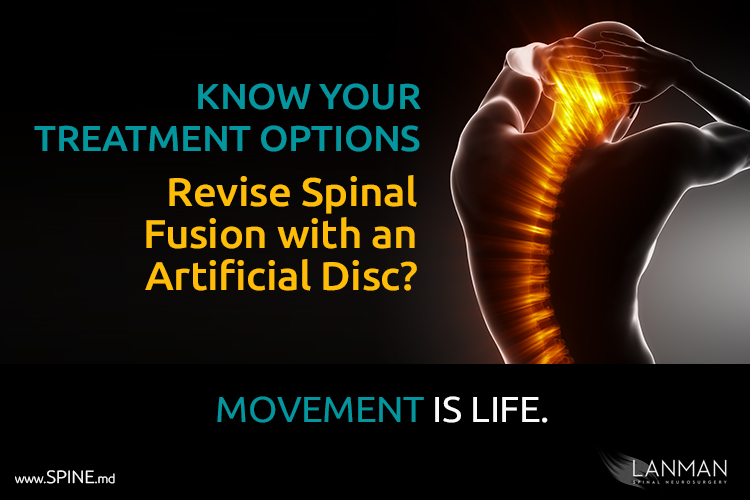Changing the course of patient outcomes with Artificial Disc Replacement surgery.
One of my patients is an avid golfer who had three disks in her neck fused. It had been several years since her last surgery, and she was developing new pain in her neck. Not only were the fusions limiting the range of motion of her spine, but persistent pressure on adjacent levels had also degenerated the disc below the fusions. After she had received this diagnosis and the prognosis for additional fusions, that’s when she decided she needed to do some research.
One of the last things she wanted, and of course who can blame her, was to have four of her discs fused. Especially at her age – she was in her 60s and was very active. In my opinion, spinal fusion should only be applied in extreme cases when there are better, more productive treatment options available.
This patient studied her choices. Her biggest concern was that the new pain came from an area of her spine that had not been operated upon. An adjacent disc was failing. The more she researched, the more she was determined to find a better option. Her research led her to artificial disc replacement surgery and recent clinical studies that showed significantly better results for artificial discs over spinal fusion. That’s when she became aware of my work at Cedar-Sinai Medical Center in Los Angeles and of my practice in Beverly Hills as a spinal neurosurgeon and my emphasis on motion preservation.
When I met her, I found that she was an excellent candidate for artificial disk replacement in an off label FDA manner. Once we got into the conversation about what ADR could do for her, she asked if there was any chance I could reverse some of the previous fusions, even though she had her surgery several years ago. The quick answer is that I can revise spinal fusions into artificial disc replacements. I have done it for several of my patients. It requires quite a lot of advance work on my part.
I start with a CAT scan. In this case, I use CAT instead of MRI to assess the facet joints of the spine where the fusion has occurred. Patients who have undergone cervical anterior (neck) spinal fusion are operated through the front of the neck. In these cases, the facet joints, which are on the other side of the spine (posterior) are often not fused. When the facet joints are still open and appear healthy, I can remove the fusion and place an artificial disk.
Her CAT scans showed that the facet joints looked open. As confirmation of the CAT findings, I will use x-ray imaging during surgery. After I drilled out the fusion, I used distracters to spring open and close the disc space and used imaging during surgery that demonstrated that the facets in the affected area were moving normally I inserted the artificial discs. In a matter of a few hours, she went from three-level fusion in her neck to two-level fusion with two artificial discs.
My only caution in these cases is that this kind of hybrid procedure is “off-label” for the artificial disc. In other words, the FDA has not evaluated specific studies for this type of procedure. However, the FDA does not regulate how a physician chooses to use an FDA approved device. If the doctor feels that a hybrid approach is in the patient’s best interest, the doctor is free to operate. All that is required is that the patient is fully informed ahead of time.
Many of my patients do quite a lot of research well before they ever call me. This was no different. She was aware of my experience with hybrid procedures of this kind. She was confident that it could be undertaken successfully. In fact, I urge that all my patients collect as much information as possible. In my experience and that of many of my colleagues, a well-informed patient is the best kind of patient.
By the time many of my patients meet me for the first time, they’re the ones telling me about the difference between spinal fusion and artificial disc replacement. In this story, my patient told me about professional golfers that had fusions performed, and it ends up a career-ending event. In my experience, it doesn’t matter what sport or whether they’re professional or not – fusion is the end of motion. Period.
Among my artificial disc patients are professional baseball pitchers, tennis players, and several golfers. These are among the most informed patients I have the pleasure of seeing. To them, artificial disc replacement is a career-saving option. The way they see it, artificial discs will help them retain functional natural motion that will enable them to continue playing.
I have seen more patients with failed fusions. I’m seeing more and more patients who want a more permanent solution that grants them full movement and relief from nerve and median back pain. Moreover, I will continue to work with like-minded neurosurgeons and compile additional clinical studies that demonstrate the successful outcomes of artificial discs over fusion. Not only does the technology exist to save patients from fusion, but it is also available as a viable solution for patients with fusion who experience the type of failures as in this story. Revisioning spinal fusion is possible with artificial disc technologies on selected cases; patients who have had prior fusions are not condemned to live with fusion for the rest of their lives.
Remember that the earlier you see a doctor and have your back or neck pain examined and diagnosed, the more treatment options you will have. Whatever you ultimately decide to do, don’t simply suffer. Get it check out.
Your health and well-being depend on preserving mobility that keeps you functional; that allows you to enjoy life the way you want to live it. Celebrate your health and wellness with painless and full MOVEMENT of your spine!
###






